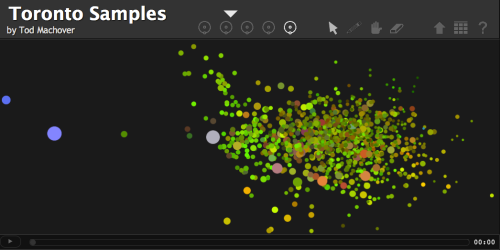The Arts section of this past Sunday’s Boston Globe brought me an article by Jeremy Eichler about composer Tod Machover and his newest commission, A Toronto Symphony. If you’re not familiar with Machover’s work, he has spent his career developing technology that pushes the boundaries of both music making and music composition, and he currently directs the Opera of the Future group at MIT.
For A Toronto Symphony Machover asked Torontonians to collaborate with him in creating a piece that would truly capture their experience of the city. As Eichler writes, “He wanted to write a symphony not for the city of Toronto by with the city of Toronto, a piece of music that would ultimately be about Toronto in a way that was granular, participatory, and reflective of an urban landscape in all of its component parts.” There’s an excellent 22-minute video at the ideacity website of Machover explaining the Toronto project when it launched. The symphony has eight parts:
- OVERTURE: the city wakes
- CITY SOUNDS: based on crowd-sourced, recorded sounds of Toronto (listen to some of these sounds via Soundcloud here and here)
- CITY STORIES: people’s stories of the city, made into music and woven together
- IMAGINING THE CITY: “a memory of Toronto when one is far far away”
- IN THE CITY: a collage of on-the-ground moments throughout the city’s neighborhoods
- CITY SOARING: the birds-eye view of Toronto
- TORONTO DANCES: “a big dance party, a kind of ‘Song to Toronto'”
- THE CITY SLEEPS: rocking the city to sleep
Machover posted a series of calls for various forms of participation on the project website, took part in local festivals, and worked with school children, musicians, and individuals from all over the city, not only to identify what Toronto sounds like but also to shape the actual musical composition. His team from MIT developed a group of new applications (best accessed via Google Chrome), including Media Scores, Constellation, and City Soaring, that allow people to play around with and modify Machover’s core Toronto composition using graphic tools–colors, shapes, lines–such that no musical training is necessary to participate. I spent a little time with these tools today and particularly liked Constellation. It felt like a glorious experiment in synesthesia.
In the Globe article Machover makes this point about the collaborative nature of A Toronto Symphony: “If it feels in the end like basically my piece no matter what, or like a mash-up of other people’s stuff that I facilitated, I think that would be less satisfying. But if it’s something that couldn’t have been made without each other, it will feel really good.” This project, and this quote, speak volumes to me about the current work of city museums. I want them to be like Tod Machover: using their expertise to bring out the best in each of us and illuminate our collective experience of the city; doing it through participation, interdisciplinary learning, and new tools that help us see the city in a different light.
The piece debuts with the Toronto Symphony Orchestra on March 9 in Roy Thomson Hall as part of the New Creations Festival. Put it on your calendar. Meanwhile, apparently two other cities have already approached Machover about further city symphony collaborations. Maybe one of them is yours?







